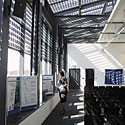Selling the Light of Day
Building-integrated photovoltaics take off
The limited product applications and the perception of PVs as an additional cost to a building, as well as the owner-driven demand that PVs have a "payback" associated with their installation, has led many solar consultants to push toward building-integrated photovoltaics. "In a first-class building, the cost of the facade is significant, so the cost of putting photovoltaics on it versus granite or another material may actually be less," says Andrew Wilkinson, with Arup's Newcastle office in England. He adds that the photovoltaic industry's biggest challenge lies in producing panels and systems attractive enough for architects to want to incorporate them into their buildings. "The question we're asking now is, if you're given a free hand, what sort of module would you like," Wilkinson says.
While traditional PV installations-rectangular modules mounted to secondary roof structures-continue in wide use, in the past few years, a rash of new options has hit the market to address the aesthetic issues of PV use. Photovoltaic shingles, meant to replace conventional asphalt or concrete roofing shingles, have wide application in the residential market. Many manufacturers offer this type of product.
Kyocera Solar, a dominant Japanese company, has targeted the California market, which practically all solar consultants and manufacturers consider the third-largest market for PVs behind Japan and Germany, mainly owing to state government incentives. Kyocera offers the MyGen Meridian product, a polycrystalline silicon cell from Japan integrated into a product that seamlessly ties into concrete shingle roofs. Jesse Henson, based at Kyocera's U.S. headquarters in Scottsdale, Arizona, said building-integrated PVs owe their cost-effectiveness in large part to their ability to take advantage of existing labor on a job site. "We also need a more streamlined utility connection protocol," Henson says. "Now, each utility or municipality is different, so very few PV installers operate on a national level."
Other companies, such as Uni-Solar, make PV shingles for residential use. Uni-Solar also manufacturers a roll-on PV cell that can be incorporated into roofing membranes to be deployed onto large-scale warehouse and manufacturing facility roofs. Konarka makes a similar product based on different technology. Solarworld, which bought Shell Solar's silicon PV business, originally developed by Siemens, produces a conventional silicon PV module that is most typical of rooftop applications. Many companies, such as BP Solar and Kyocera, produce PVs laminated between sheets of glass. Atlantis Energy, which produces glass-laminated PVs in Sacramento, California, supplied the Wagner Park project discussed earlier. Joe Morrissey, of Atlantis, said he is hopeful UL will begin to certify whole lines of PV products, as opposed to the project-by-project basis now in place. While limitless options are available to an architect, Morrissey said he spends a great deal of time explaining photovoltaics. "I feel like we're educators too much," Morrissey says. "We're really trying to get beyond that so people can understand the process of actually incorporating them into their buildings."
Advising nonresidential clients to invest in a large-scale PV installation should be part of an overall energy-efficiency design strategy, according to Nico Kienzl, a building energy consultant in Atelier Ten's New York office. "In most projects, it makes more sense to install an advanced lighting and control system, a better HVAC system, and a good building envelope, and then, if you have money to spare, you could install photovoltaics," Kienzl says. However, placing a PV installation in atrium glass or on a canopy can signify a client's commitment to sustainability, which Kienzl says often rightly overrides decisions based purely on payback. "The danger is that people will view PVs as a technology fix, when PVs alone are never going to get us there."
Kienzl begins a PV design proposal by creating a sun path diagram for the building. This diagram helps explain where it makes the most sense to install PVs on a building by indicating shadows from neighboring structures and zones with the highest incidence of sunlight during various times of the year. This information guides Kienzl in recommending building surfaces for PV use, as well as the most appropriate angle for PVs if they are installed on canopies or awnings. Determining what surface to use on a building exterior can sometimes run aground of warranty issues, since an awning supplier and installer may not certify the product if a PV contractor has affixed modules to them. Kienzl says any PV installation is often, if not always, an intense collaborative effort between the PV manufacturer and the design team, though this doesn't always need to occur during the initial construction of the building. "PVs are a great technology because the cells can always be added later," Kienzl says, noting that while only 5 percent of his projects contain PV installations, the majority of his clients consider them for their buildings.












